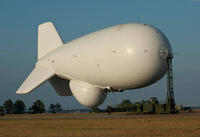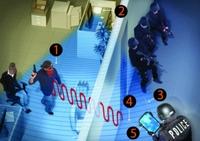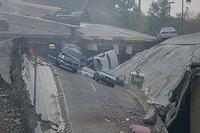-
First class of U.S. Army soldiers completed training with Raytheon's JLENS

JLENS uses a powerful integrated radar system to detect, track, and target a variety of threats, allowing military units to defend against threats, including hostile cruise missiles, low-flying manned and unmanned aircraft, large caliber rockets, and moving surface vehicles such as boats, SCUD-launchers, automobiles, and tanks
-
-
NYPD, Microsoft develop and deploy new surveillance system
The New York Police Department (NYPD) and Microsoft have teamed up to create the Domain Awareness System, which will analyze real-time safety data for use by NYPD investigators; the system will act as a communications hub which will allow a number of advanced counterterrorism systems to relay information to more than 1,000 people in the field
-
-
Engineers solve leaky water pipes problem

Leaky pipes are a common problem for the water industry: according to the U.K. Water Services Regulation Authority (OFWAT), between 20 and 40 percent of our total water supply can be lost through damaged pipes; developing more accurate ways of finding leaks would enable water companies to save revenue and reduce their environmental impact
-
-
Seeing through walls with the help of laser systems
Inspired by the erratic behavior of photons zooming around and bouncing off objects and walls inside a room, researchers combined these bouncing photons with advanced optics to enable them to “see” what is hidden around the corner
-
-
Seeing through walls, clearly

Research and tests show, for the first time, the ability to use t passive WiFi radar for through-the-wall (TTW) detection of moving personnel – and do so covertly
-
-
New, affordable instant warnings of bridge collapse

The Federal Bureau of Transportation lists nearly 70,000 U.S. bridges as “structurally deficient,” requiring extra surveillance; in addition, more than 77,000 others are categorized as “obsolete” — exceeding their intended lifespan and carrying loads greater than they were designed to handle; researchers developed a new technology for monitoring these 150,000 aging U.S. highway bridges
-
-
Seismic sensors seek source of Spokane quakes
It has been a decade since a swarm of relatively mild earthquakes shook up parts of Spokane, Washington; now, armed with the right tools, scientists want to find out what was at fault
-
-
Miniature sensors to advance climate studies, battlefield detection
Self-sealing valves are not only better for collecting reliable climate information – they also increase data reliability for airborne industrial and battlefield gas detection and point-of-contact medicine
-
-
International collaborative effort to develop better radiation detection tool
In mid-February, the Flash Portal Project was launched with the aim of furthering the development and testing of a new technology to detect shielded nuclear materials
-
-
Scientists develop new concrete corrosion sensors
Scientists have made a major breakthrough in developing sensors which dramatically improve the ability to spot early warning signs of corrosion in concrete; the sensors will make monitoring the safety of structures such as bridges and vital coastal defenses much more effective
-
-
Wireless sensors effective in protecting critical infrastructure
A key to critical infrastructure security is effective monitoring of such infrastructure; a European research project has now successfully demonstrated a wireless sensor-based solution for cost-effective monitoring of electricity distribution networks and water networks
-
-
Tracking nerve agents back to the source where terrorists got it
Scientists are reporting development of a first-of-its-kind technology that could help law enforcement officials trace the residues from terrorist attacks involving nerve gas and other chemical agents back to the companies or other sources where the perpetrators obtained ingredients for the agent
-
-
Universal Detection developing radiation detector for smartphones
Last week Universal Detection Technology announced that it had begun development of a radiation detection device designed to work with smart phones
-
-
Rapiscan to develop advanced nuke detection tech for DHS
DHS’ Domestic Nuclear Detection Office (DNDO) recently awarded Rapiscan Systems a contract worth as much as $7 million to develop advanced new technologies to address the nation’s most pressing challenges in detecting nuclear materials
-
-
Innovative surveillance solutions recognized
MicroObserver Unattended Ground Sensor from Textron Defense Systems was recognized as one of the 2011 Big 25 intelligence, surveillance, and reconnaissance (ISR) products; the solution detects and tracks vehicles and personnel for perimeter defense, border security, force protection, persistent surveillance, and critical infrastructure protection
-
- All
- Regional
- Water
- Biometrics
- Borders/Immig
- Business
- Cybersecurity
- Detection
- Disasters
- Government
- Infrastructure
- International
- Public health
- Public Safety
- Communication interoperabillity
- Emergency services
- Emergency medical services
- Fire
- First response
- IEDs
- Law Enforcement
- Law Enforcement Technology
- Military technology
- Nonlethal weapons
- Nuclear weapons
- Personal protection equipment
- Police
- Notification /alert systems
- Situational awareness
- Weapons systems
- Sci-Tech
- Sector Reports
- Surveillance
- Transportation
Advertising & Marketing: advertise@newswirepubs.com
Editorial: editor@newswirepubs.com
General: info@newswirepubs.com
2010-2011 © News Wire Publications, LLC News Wire Publications, LLC
220 Old Country Road | Suite 200 | Mineola | New York | 11501
Permissions and Policies
Editorial: editor@newswirepubs.com
General: info@newswirepubs.com
2010-2011 © News Wire Publications, LLC News Wire Publications, LLC
220 Old Country Road | Suite 200 | Mineola | New York | 11501
Permissions and Policies
